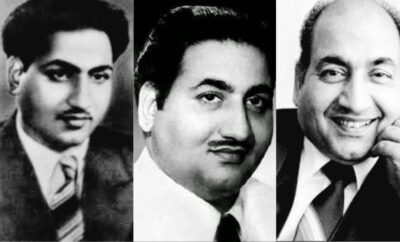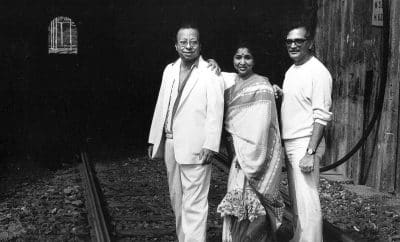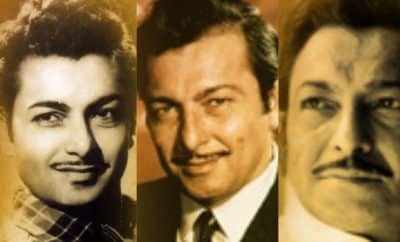Song Sketch
Rendezvous With Life – Paas Aao Na – Chala Murari Hero Banane
Rendezvous with life: With Simi Garewal
“Paas aao na”
-Chala Murari Hero Banane-
Singers – Asha Bhosale-Simi Garewal- Chorus
Music : Rahul Devburman
Lyricist : Yogesh Gaur
We have often seen the appointments with death, courtesy Amitabh Bachchan, the famous instances being from Deewar (along with ‘I am falling in love’) , the poem recital in Anand (‘Ae Maut tu ek kavita hai’) and Agnipath.
This song is for a change, an appointment with life arranged for Asrani in his reel life in ‘Chala Murari Hero banane’ by Simi Garewal.
‘Rendezvous with life’ ,hence, would be more apt, no?
This song article is mainly penned as a tribute to the recently departed lyricist , Yogesh ji Gaur, who has told the philosophies of Life in such simple yet meaningful phrases which sometimes would ‘Hansaye’ ( make us laugh/ smile) and sometimes ‘rulaye’ (bring tears in our eyes).
2020 has been a very hard year so far with the pandemic of Corona creating a havoc in almost every human’s life on this Earth and loss of many dear-to-the-heart film personalities like Rishi Kapoor, Irrfan Khan and Yogesh Ji ( to name a few) that would make one sing ‘ Naa jaane din kaise jeevan mein aaye hai’. Yes, the soulful Kishore kumar solo from ‘Chala Murari Hero banane’ which does not come out of the loop of the depression even after trying hard to find breakthrough through the antara crossover.
But life has to go on and we are now finding some light at the end of the dreadfully dark tunnel. If the earlier Kishore da solo was the submission to the calamities in Asrani’s reel and real life, other three solos of Asha Bhosale from same film have hope and promise written all over and why not? The singer’s name is the synonym of Hope playbacks for Asrani s heroines/ well wishers in the effort of lifting his spirit or helping him in some or other way.
Pancham’s youthful and inspiring musical treatment also comes to the party. Yogesh ji was known to become one with the dhoon, meter and situation of the song and the characters for which he wrote. He penned different kinds of philosophies as per the demand of each of the three songs.
He was inspiringly energetic with
‘Khoye ho aakhir kis bekhudi mein
kuchh aur bhi hai is zindagi mein’
for Murari’s true friend who turns his lover, Bindiya Goswami. Yogesh ji also infused that bubbly ‘zubi zubiya zoo biya’ for Murari’s friends comprising mainly the members of Nukkad gang. The words may not make a sense but their phonetic effervescence certainly added a unique flavor.
In the other song, ‘do pal ki hai yeh zindagani’, a song picturisation actually, Yogesh ji’s words with khanak ( ringing sound) were musically instrumental in portraying the life of the character living dangerously on the edge yet enjoying it to the fullest.
Sample this:
‘Do pal ki hai yeh zindagani,
har saaz ke taar ki
jab tak chale yeh saans gaa lo
koi ghazal pyar ki’.
I am always bowled by the placement of ‘ghazal’ in a fully western cabaret atmosphere. But he did it sweetly and convincingly.
Now (finally) coming to the song in the context, “Paas aao na”. Here, he depicts the philosophy of how to lead a tension free life in a different somewhat carefree manner not caring a damn about the world. The song has much more to offer just like the multi dimensioned / faceted life, of course no wonders there when the composer is loRD himself and the lyricist like Yogesh ji in perfect sync. Not to forget Asha ji who has the support of ‘Simi’ lyrical dialogues from the sleek actress with western image and accent and the crooning of the invisible chorus.
The song starts adlib with the monologue of Asha
“Kya soch rahe ho?
Pyar karte ho aur sochte ho?
Umm hmmm..Naughty.. “
Such a lovely informal start with the gems of informal touches like the ‘tch’ tease and that sensual ‘naughty’ ( in true western accent). Mark how the guitar strums sneak in to cling to the sensual voice of Asha Bhosale , the style so quintessential RD.
“Socho Mat….
Sab bhool jaao”
The whispering element in her voice gives a perfect healing massage to the churning brain making it forget everything and get lost in the sensual magic and ALL OF A SUDDEN, A HIGH PITCH
“DEKHO MERI TARAF, DEKHO”
rises from nowhere to arouse him in a surprise and completely mesmerize him with the content that follows after.
“Kya main sochti hoon?
Umm Hummm
Jo dil mein aata hai
Wahee karti hoon
Jitni duniya ki parwaah karoge
Apne aap se door hote jaaoge”
The song pace is still in the ambling stage, a warm-up session actually, pretty essential to send him/ us in the hypnotic stage and finally Pancham gives a green signal / thumbs up to Asha along
“So…..let’s go!!!!
Kaheeee doooooor chale”
and the song simply zooms on the progression road just like the vehicle Asrani is driving in the film. This was just the bridge that separated the real world and the fantasy world.
Asha speeds in with her aalap as the rhythm too joins in to support her. Now the musical proceedings start in true sense but still no words in sight as she continues a full cycle of opening in her “yya yya yya ya”
The muted trumpets join her in due course and the crooning chorus also follows suit. The trumpets pick batten from the vocal trumpet of Pancham, Asha, to complete the cycle. Trumpets and the crooning chorals then play a wonderful tango with the support of a party kind rhythm. The chorus finally leads to the bold vocals of Asha
“Kya hai Samaa kaisi haseen
bikhari hai yeh tanhaiyaan
(Oh how I love this phrase, not heard so far)
Rangon ke mele hai
Hum tum akele hai
Aise mein kuchh socho na
Hooooo
Paas aao na, tarsaao naa
Ae jaane jaan”
Don’t miss to enjoy the brief halt after ‘tanhaaiyaan’ when Asha with the help of crisp little pickup launches into the flight with a gush that is buoyed by a timely choral support. And then she descends as quickly, yet without jerks, as she rose (as if nothing had happened) along the sensual and silky soft hum(ming).
So much enjoyment, so many layers, so many ups and downs, one would be satisfied to continue..but this is extravagance of Pancham. He brings in a surprise element, yes, he introduces the voice of Ms Grewal who enters in with her Simi-lyrical monologues as the song re-starts.
You would wonder Pancham could have introduced her right at the start instead of Asha. Of course, listening to her silky soft vocals with perfect western accent with which she immortalized the countless ‘rendezvous’ shows you would appreciate the genius of Pancham and his dramatic style of introducing the vocal and instrumental elements.
She continues with a sensual sigh and
“Phir sochne lage ho! Umm humm Dekho kitni khubsoorat raat hai, isn’t it lovely ? Isn’t it romantic? Aur main? Main bhi is raat ki tarah hoon, masssti bhari..mujh mein kho jaao..paas aao..paas aao naa! “
Like me, you will appreciate what we were missing in Asha’s monologues so far, the sensual finesse that Simi possesses when it comes to prose. How well she recreates the calm ambience of a private night!!
Suddenly, you are awakened by the bold re-entry by Asha that punctuates the calm darkness of night with the sensual blaze along
“Tum ho jawaan
Main bhi jawaan
Phir kyun sahe.. he..
yeh dooriyaan
Madhosh Baahon mein
Pyaasi nigaahon mein
Aaj tu Kho jaao na
Heyy
Paas aao na, tadpaao naa
Ae jaane jaan”
While you enjoy the sequence of pickup- gush-descent again you may notice that this song is actually a antara starter with the real hook line being “Paas aao na”. With the things going same way as previous instance, you would make yourself ready with another ‘rendezvous’ with the sensual monologues of Simi. But minddd itt! Pancham is the king of the surprises. Instead of continuing in the same crooning vein like the diffused vocal ending of Asha he brings in Basu Da with his fantastic ensemble and the gay accordions in full blow and flow.
The guitar strums press the brake pedal to check the speed as they diffuse into Asha’s huming and Simi’s sighes. Yes, the rendezvous is still ON, Pancham just delayed it to add to the list of pleasant surprises.
“Life is to live ..yess..live every moment of it ..
or else you find you are losing the most beautiful,
the most precious gift of all, the gift of youth,
listen, youth is beauty , youth is life,
youth is love so let yourselves go, come on”
Again surprise.. again..yes.. in the form of low pitched continuity by Asha, unlike the earlier, simulating the intimacy the couple is enjoying. Pancham has many times used this kind of progression from Bang start to intimate ending as in “O jaaneman zindagi hai jeene ke liye” (Chhalia 1972) and “Jaane kaise kab kahaan” (Shakti).
“Aati hai kyun angadaaiyaan ?
Socho zaraa gehraaiyaan
(the underline of soft chorals to each of above lines unlike previous instances also strengthens the depiction of the intimacy )
Dhadkanein gaati hai
Tum ko bulati hai
Jaane tum gum ho kahaan
Heyy
Paas aao na …….”
Although the later part is in the same high progression as previous the song then diffuses into the calm ambiance with the aid of the muted trumpet and the tugging-to-your-heart guitar strumming.
A little less than 6 minute long extravaganza gives you much more than you expect even with Pancham standards. The highs and lows experienced may put even turbulence in life to a shame. The endless surprises may even surprise the unknowingness of future.
Pancham has literally played with every aspect of the composition, right from its antara starter characteristics to pace changes ( High / bold antara start to the slow and whispering sign line) to the introduction of vocal and instrumental elements. He knows how to create a maze (chakravyuha), make the elements play and also how to exit.
Add to it the vocal bonanza of singing elements ( Asha, Simi and chorus) and also the close positioning of contrasting prose-semi prose and lyrical elements. Same goes with the Hindi-English monologues to the rich-in-puee-Hindi lyrical part.
Thanks to Yogeshji, of course, who used to enter the skin of the character/ situation, genre he is not generally associated with or has not confronted to it with many times. The song, in spite of being so rich in content, remains in oblivion. This ill fate is shared by many of his rich experimental compositions. The intention of such kind of articles is to arrange a ‘rendezvous’ with such unfortunate songs.
Anyways, did you, just like me, wonder where you have heard that ‘yya yya ya yya’ progression before ? Well, in my humble opinion, I heard it again in this composition by Shantanu Moitra , a faithful follower of Pancham.
No wonders there, a similar western composition where an ever youth Rekha sensually croons in to solve the riddles of life just like ‘zindagi kaisi hai paheli haaye’ as put in by our favorite lyricist in context.
Now listen to this:
Pancham composed a song, altogether different in emotion and as apart as Zameen and Aasmaan, exactly on the same progression sans the high pitch ‘paas aao na’. He of course was loRD. For him making the zameen and aasmaan meet was a child’s play.
Enjoy the marvel of a composition.



